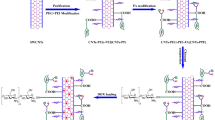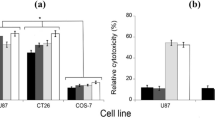Abstract
Coenzyme Q10 (CoQ10) has a wide range of physiological functions and therapeutic value. However, its biomedical application as a health product or drug is limited by its insolubility and low bioavailability. Single-walled carbon nanotubes (SWCNTs) have attracted great interest for drug or therapeutic agent delivery due to their unique properties. In this study, the pristine SWCNTs are purified with different oxidizing acid, and the resulting shortened CNTs (CNTs-COOH) are conjugated with poly-(ethylene glycol) (PEG) groups. Afterwards, CoQ10 is loaded by CNTs carriers. CNTs carriers are systematically characterized and evaluated in terms of drug loading, in vitro release, cytotoxicity, and cellular uptake. The results reveal that the sizes (length) of CNTs-COOH and CNTs-PEG are 253.2 and 328.7 nm, respectively, and they have high loading capacity for CoQ10 and low cytotoxicity toward Caco-2 cells. In comparison with CNTs-COOH, CNTs-PEG exhibited better sustained-release property for CoQ10. Also, CNTs-PEG carriers loaded with CoQ10 can be effectively delivered into cells and have enhanced cellular uptake efficiency over time. Further study results of the uptake mechanism illustrate that CNTs-PEG can be internalized into cells through the broader and more efficient entry routes, including direct penetration, clathrin-mediated endocytosis and macropinocytosis pathway. In summary, the PEG-conjugated CNTs may be used as novel nanocarriers, and the findings will contribute to the rational design of multifunctional delivery vehicles for CoQ10.
Graphical abstract








Similar content being viewed by others
References
Ali-Boucetta H, Kostarelos K (2013) Pharmacology of carbon nanotubes: toxicokinetics, excretion and tissue accumulation. Adv Drug Deliv Rev 65:2111–2119
Alkholy UM, Abdalmonem N, Zaki A, Elkoumi MA, Hashim MIA, Basset MAA, Salah HE (2019) The antioxidant status of coenzyme Q10 and vitamin E in children with type 1 diabetes. J Pediatr 95:224–230
Bates K, Kostarelos K (2013) Carbon nanotubes as vectors for gene therapy: past achievements, present challenges and future goals. Adv Drug Deliv Rev 65:2023–2033
Beg S, Javed S, Kohli K (2010) Bioavailability enhancement of coenzyme Q10: an extensive review of patents. Recent Pat Drug Deliv Formul 4:245–255
Bhattacharya K, Andon FT, El-Sayed R, Fadeel B (2013) Mechanisms of carbon nanotube-induced toxicity: focus on pulmonary inflammation. Adv Drug Deliv Rev 65:2087–2097
Bottini M, Rosato N, Bottini N (2011) PEG-modified carbon nanotubes in biomedicine: current status and challenges ahead. Biomacromolecules. 12:3381–3393
Chai GH, Xu Y, Chen SQ, Cheng B, Hu FQ, You J, du YZ, Yuan H (2016) Transport mechanisms of solid lipid nanoparticles across Caco-2 cell monolayers and their related cytotoxicology. ACS Appl Mater Interfaces 8:5929–5940
Costa PM, Bourgognon M, Wang JT, Al-Jamal KT (2016) Functionalised carbon nanotubes: From intracellular uptake and cell-related toxicity to systemic brain delivery. J Control Release 241:200–219
Donkor DA, Tang XS (2014) Tube length and cell type-dependent cellular responses to ultra-short single-walled carbon nanotube. Biomaterials. 35:3121–3131
Gong H, Peng R, Liu Z (2013) Carbon nanotubes for biomedical imaging: the recent advances. Adv Drug Deliv Rev 65:1951–1963
Hao Y, Yang X, Shi Y, Xing J, Marowitch J, Chen J, Chen J (2012) FITC delivery into plant cells using magnetic single-walled carbon nanotubes. J Nanosci Nanotechnol 12:6287–6293
Hargreaves IP (2014) Coenzyme Q10 as a therapy for mitochondrial disease. Int J Biochem Cell Biol 49:105–111
Hargreaves IP, Mantle D (2019a) Coenzyme Q10 supplementation in fibrosis and aging. Adv Exp Med Biol 1178:103–112
Hargreaves IP, Mantle D (2019b) Supplementation with selenium and coenzyme Q10 in critically ill patients. Br J Hosp Med (Lond) 80:589–593
Karchemski F, Zucker D, Barenholz Y, Regev O (2012) Carbon nanotubes-liposomes conjugate as a platform for drug delivery into cells. J Control Release 160:339–345
Karimi M, Solati N, Ghasemi A, Estiar MA, Hashemkhani M, Kiani P, Mohamed E, Saeidi A, Taheri M, Avci P, Aref AR, Amiri M, Baniasadi F, Hamblin MR (2015) Carbon nanotubes part II: a remarkable carrier for drug and gene delivery. Expert Opin Drug Deliv 12:1089–1105
Khattab A, Hassanin L, Zaki N (2017) Self-nanoemulsifying drug delivery system of coenzyme (Q10) with improved dissolution, bioavailability, and protective efficiency on liver fibrosis. AAPS PharmSciTech 18:1657–1672
Kumar S, Rani R, Dilbaghi N, Tankeshwar K, Kim KH (2017) Carbon nanotubes: a novel material for multifaceted applications in human healthcare. Chem Soc Rev 46:158–196
Kumar S, Rao R, Kumar A, Mahant S, Nanda S (2016) Novel carriers for coenzyme Q10 delivery. Curr Drug Deliv 13:1184–1204
Lee PC, Chiou YC, Wong JM, Peng CL, Shieh MJ (2013) Targeting colorectal cancer cells with single-walled carbon nanotubes conjugated to anticancer agent SN-38 and EGFR antibody. Biomaterials. 34:8756–8765
Li Z, de Barros ALB, Soares DCF, Moss SN, Alisaraie L (2017) Functionalized single-walled carbon nanotubes: cellular uptake, biodistribution and applications in drug delivery. Int J Pharm 524:41–54
Liu HT, Huang YC, Cheng SB, Huang YT, Lin PT (2016) Effects of coenzyme Q10 supplementation on antioxidant capacity and inflammation in hepatocellular carcinoma patients after surgery: a randomized, placebo-controlled trial. Nutr J 15:85
López-Lluch G, Del Pozo-Cruz J, Sánchez-Cuesta A, Cortés-Rodríguez AB, Navas P (2019) Bioavailability of coenzyme Q10 supplements depends on carrier lipids and solubilization. Nutrition. 57:133–140
Mao H, Kawazoe N, Chen G (2013) Uptake and intracellular distribution of collagen-functionalized single-walled carbon nanotubes. Biomaterials. 34:2472–2479
Markley HG (2012) CoEnzyme Q10 and riboflavin: the mitochondrial connection. Headache. 52(Suppl 2):81–87
Mehra NK, Jain K, Jain NK (2015) Pharmaceutical and biomedical applications of surface engineered carbon nanotubes. Drug Discov Today 20:750–759
Mishra V, Kesharwani P, Jain NK (2018) Biomedical applications and toxicological aspects of functionalized carbon nanotubes. Crit Rev Ther Drug Carrier Syst 35:293–330
Mohammadi M, Salmasi Z, Hashemi M, Mosaffa F, Abnous K, Ramezani M (2015) Single-walled carbon nanotubes functionalized with aptamer and piperazine-polyethylenimine derivative for targeted siRNA delivery into breast cancer cells. Int J Pharm 485:50–60
Prakash S, Malhotra M, Shao W, Tomaro-Duchesneau C, Abbasi S (2011) Polymeric nanohybrids and functionalized carbon nanotubes as drug delivery carriers for cancer therapy. Adv Drug Deliv Rev 63:1340–1351
Ross SM (2007) Coenzyme q10: ubiquinone: a potent antioxidant and key energy facilitator for the heart. Holist Nurs Pract 21:213–214
Tafazoli A (2017) Coenzyme Q10 in breast cancer care. Future Oncol 13:1035–1041
Taghavi S, HashemNia A, Mosaffa F, Askarian S, Abnous K, Ramezani M (2016) Preparation and evaluation of polyethylenimine-functionalized carbon nanotubes tagged with 5TR1 aptamer for targeted delivery of Bcl-xL shRNA into breast cancer cells. Colloids Surf B: Biointerfaces 140:28–39
Takahashi M, Takahashi K (2019) Water-soluble CoQ10 as a promising anti-aging agent for neurological dysfunction in brain mitochondria. Antioxidants (Basel) 8
Wong BS, Yoong SL, Jagusiak A, Panczyk T, Ho HK, Ang WH, Pastorin G (2013) Carbon nanotubes for delivery of small molecule drugs. Adv Drug Deliv Rev 65:1964–2015
Wu H, Shi H, Zhang H, Wang X, Yang Y, Yu C, Hao C, du J, Hu H, Yang S (2014) Prostate stem cell antigen antibody-conjugated multiwalled carbon nanotubes for targeted ultrasound imaging and drug delivery. Biomaterials. 35:5369–5380
Yang S, Song S, Han K, Wu X, Chen L, Hu Y, Wang J, Liu B (2019) Characterization, in vitro evaluation and comparative study on the cellular internalization of mesoporous silica nanoparticle-supported lipid bilayers. Microporous Mesoporous Mater 284:212–224
Yang S, Wang X, Jia J, Li P (2016) Release property study on the novel divalproex sodium enteric-coated capsules. Saudi Pharm J 24:245–249
Zhu M, Nie G, Meng H, Xia T, Nel A, Zhao Y (2013) Physicochemical properties determine nanomaterial cellular uptake, transport, and fate. Acc Chem Res 46:622–631
Acknowledgements
This work was financially supported by the Foundation for University Key Teacher by Henan University of Technology (No. 21420075), the National Key Research and Development Plan (No. 2016YFD0400200), the Natural Science Research Program of the Education Department of Henan Province (21A350003), the Key R&D and Promotion projects of Henan Province (Scientific and technological research project, No. 192102310419), and Natural Science Project of Zhengzhou Science and Technology Bureau (No. 20150507).
Author information
Authors and Affiliations
Corresponding authors
Ethics declarations
Competing interests
The authors declare that they have no competing interests.
Additional information
Publisher’s note
Springer Nature remains neutral with regard to jurisdictional claims in published maps and institutional affiliations.
Rights and permissions
About this article
Cite this article
Yang, S., Niu, Y., Li, L. et al. PEG-conjugated single-walled carbon nanotubes enhance the cellular uptake of Coenzyme Q10: in vitro evaluation and mechanism study. J Nanopart Res 23, 114 (2021). https://doi.org/10.1007/s11051-021-05214-4
Received:
Accepted:
Published:
DOI: https://doi.org/10.1007/s11051-021-05214-4




